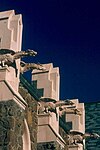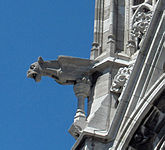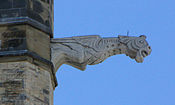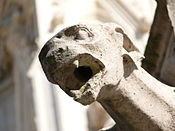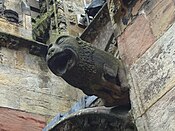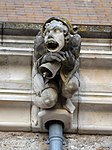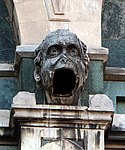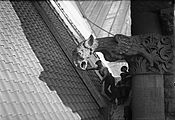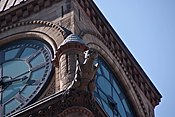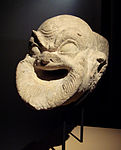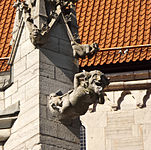Gargoyle

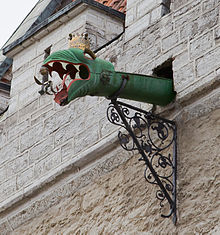

Inarchitecture,and specificallyGothic architecture,agargoyle(/ˈɡɑːrɡɔɪl/) is a carved or formedgrotesque[1]: 6–8 with a spout designed to convey water from a roof and away from the side of a building, thereby preventing it from running downmasonrywalls and eroding themortarbetween. Architects often used multiple gargoyles on a building to divide the flow of rainwater off the roof to minimize potential damage from rainstorms. A trough is cut in the back of the gargoyle and rainwater typically exits through the open mouth. Gargoyles are usually elongated fantastical animals because their length determines how far water is directed from the wall. WhenGothicflying buttresseswere used,aqueductswere sometimes cut into the buttress to divert water over the aisle walls.[2]
Etymology
[edit]The term originates from theFrenchgargouille,which in English is likely to mean "throat" or is otherwise known as the "gullet";[3][4]cf.Latingurgulio, gula, gargula( "gullet" or "throat" ) and similar words derived from the rootgar,"to swallow", which represented the gurgling sound of water (e.g.,PortugueseandSpanishgarganta,"throat";gárgola,"gargoyle" ). It is also connected to the French verbgargariser,which shares a Latin root with the verb "gargle"[1]: 8 [5]and is likely imitative in origin.[6]TheItalianword for gargoyle isdoccioneorgronda sporgente,an architecturally precise phrase which means "protruding gutter". Italian also usesgargollaorgarguglia,when it has a grotesque shape.
When not constructed as a waterspout and only serving an ornamental or artistic function, the technical term for such a sculpture is agrotesque,chimera, orboss.There are also regional variations, such as thehunky punk.Just as withbossesandchimeras,gargoyles are said to protect what they guard, such as a church, from any evil or harmful spirits.
Legend of the Gargouille
[edit]A French legend that sprang up around the name ofSt. Romanus(French:Romain;fl.c. 631–641 AD), the former chancellor of theMerovingiankingChlothar IIwho was madebishop of Rouen,relates how he delivered the country around Rouen from a monster calledGargouilleorGoji.[7][8]La Gargouille is said to have been the typical dragon with bat-like wings, a long neck, and the ability to breathe fire from its mouth. Multiple versions of the story are given, either that St. Romanus subdued the creature with a crucifix, or he captured the creature with the help of the only volunteer, a condemned man. In each, the monster is led back to Rouen and burned, but its head and neck would not burn due to being tempered by its own fire breath. The head was then mounted on the walls of the newly built church to scare off evil spirits, and used for protection.[9]In commemoration of St. Romain, the Archbishops of Rouen were granted the right to set a prisoner free on the day that thereliquaryof the saint was carried in procession (see details atRouen).[10][11]
History
[edit]The termgargoyleis most often applied tomedievalwork, but throughout all ages, some means of water diversion, when not conveyed in gutters, was adopted.[12]Inancient Egyptianarchitecture, gargoyles showed little variation, typically in the form of a lion's head.[13]Similar lion-mouthed water spouts were also seen onGreek temples,carved or modelled in themarbleorterracottacymatiumof thecornice.[14]An excellent example of this are the 39 remaining lion-headed water spouts on theTemple of Zeus.[clarification needed]Originally, it had 102 gargoyles or spouts, but due to the heavy weight (they were crafted from marble), many snapped off and had to be replaced.[15][16]
Many medieval cathedrals included gargoyles and chimeras.[17]According to French architect and authorEugène Viollet-le-Duc,himself one of the great producers of gargoyles in the 19th century,[18]the earliest known medieval gargoyles appear onLaon Cathedral(c. 1200–1220).[19]One of the more famous examples is the gargoyles ofNotre-Dame de Paris.Although most have grotesque features, the term gargoyle has come to include all types of images. Some gargoyles were depicted as monks, or combinations of real animals and people, many of which were humorous. Unusual animal mixtures, or chimeras, did not act as rainspouts and are more properly called grotesques. They serve as ornamentation but are now popularly called gargoyles.
Both ornamented and unornamented waterspouts projecting from roofs at parapet level were a common device used to shed rainwater from buildings until the early 18th century. From that time, more and more buildings used drainpipes to carry the water from thegutteringroof to the ground and only very few buildings using gargoyles were constructed. This was because some people found them frightening, and sometimes heavy ones fell off, causing damage. In 1724, the London Building Act passed by theParliament of Great Britainmade the use of downpipes compulsory in all new construction.[20]
Catholic Church
[edit]
There are divided ideas as to the purpose of adding gargoyles to religious structures. Some state that gargoyles were meant to illustrateeviland sin, while others have posited that grotesques in architecture wereapotropaicdevices.[21]In the 12th century, before the use of gargoyles as rain spouts,St. Bernard of Clairvauxwas famous for speaking out against gargoyles carved on the walls of his monastery's cloister:[22]
What are these fantastic monsters doing in the cloisters before the eyes of the brothers as they read? What is the meaning of these unclean monkeys, these strange, savage lions and monsters? To what purpose are here placed these creatures, half beast, half man or these spotted tigers? I see several bodies with one head and several heads with one body. Here is a quadruped with a serpent's head; there a fish with a quadruped's head; then again an animal: half horse, half goat... Surely, if we do not blush for such absurdities, we should at least regret what we have spent on them.[23][24]
According to Lester Burbank Bridaham, writing inGargoyles, Chimeres and the Grotesque in French Gothic Sculpture,"There is much symbolism in the sculpture of the Gothic period; but we must be wary of reading in too much meaning."[25]
Animal
[edit]Theancient Egyptians,Greeks,Etruscans,andRomansall used animal-shaped waterspouts.[1]: 11 During the 12th Century, when gargoyles appeared in Europe, the Roman Catholic Church was growing stronger and converting many new people. Most of the population at this time was illiterate, so images were very important to convey ideas. Many early gargoyles depicted some version of a dragon, especially in France. In addition to serving as spouts for water, the gaping mouths of these gargoyles evoked the fearsome destructiveness of these legendary beasts, reminding the laity of the need for the church's protection.[26]
Human qualities were sometimes ascribed to specific animals—that is, the animals wereanthropomorphized.This was especially common for pagans, and using these ideas helped conversion to Catholicism. Some animals (such as therhinocerosand thehippopotamus) were unknown in western Europe during the Middle Ages, so gargoyles of these species (such as the ones atLaon Cathedral) are modern gargoyles and therefore did not have symbolic meaning in Medieval times.[1]: 20
Gallery
[edit]-
A gargoyle on theBasilique du Sacré-Cœur,Paris, France, showing the water channel
-
Gargoyle ofNotre-Dame d'Amiens,France
-
Notre Dame ChurchinDijon,France
-
Gargoyle at theCloth Hall, Ypres,Belgium
-
Gargoyle onZagreb Cathedral,Croatia
-
Gargoyle fromCologne Cathedralunder reconstruction
-
Gargoyle showing carver Roger Morigi with carver's tools,Washington National Cathedral,Washington D.C.,USA
-
Gargoyle from theChâteau de Blain,France
-
Original Old City Hall, Toronto gargoyle
-
Replica gargoyles at Old City Hall, Toronto
-
A 1st century BC Hellenistic gargoyle representing a comical cook-slave fromAi Khanoum,Afghanistan
-
During a refurbishment ofPaisley Abbeyin the early 1990s, twelve gargoyles were replaced. One of them is modeled onthe titular creaturefrom the 1979 filmAlien.
-
Gargoyle spewing water as part of a fountainPrčice,Sedlec-Prčice,Příbram District, Central Bohemian Region, the Czech Republic. Vítek's Square
See also
[edit]- Architectural sculpture
- Chiwen
- Nightmares in the Sky– Coffee table book by Stephen King and f-stop Fitzgerald
- Rainhead
- Sheela na gig
References
[edit]- ^abcdBenton, Janetta Rebold (1997).Holy Terrors: Gargoyles on Medieval Buildings.Abbeville Press.ISBN978-0-7892-0182-9.
- ^"What Is a Gargoyle?".Wonderopolis.Retrieved19 October2018.
- ^Hargreaves, J. (1990).Hargreaves New Illustrated Bestiary.Gothic Image Publications. p. 51.ISBN978-0-906362-12-9.RetrievedMay 11,2018.
The word Gargoyle is derived from 'La Gargouille'—the name of an immense dragon who lived in the river Seine at Rouen. The word Gargouille comes from the word for a throat, and gargle is derived from the same source. La Gargouille was...
- ^Houghton Mifflin(2000).The American Heritage Dictionary of the English Language(4th ed.). Boston and New York: Houghton Mifflin. pp.725.ISBN978-0-395-82517-4.
- ^"gargle".Origin and meaning of gargle by Online Etymology Dictionary.RetrievedMay 11,2018.
- ^"Word of the Day: Gargoyle".Merriam-Webster.September 5, 2015.Archivedfrom the original on June 24, 2017.RetrievedMay 11,2018.
- ^Butler, A.; Thurston, H.; Attwater, D. (1956).Lives of the Saints.Kenedy. p. 183.RetrievedMay 11,2018.
ST ROMANUS, Bishop of Rouen (c. a.d. 640) Not much that is certainly authentic is known of this bishop.... The legend is that this privilege took its rise from St Romanus killing a great serpent, called Gargouille, with the assistance of a...
- ^Herbermann, C.G.; Pace, E.A.; Pallen, C.B.; Shahan, T.J.; Wynne, J.J.; MacErlean, A.A. (1913).The Catholic Encyclopedia: An International Work of Reference on the Constitution, Doctrine, Discipline, and History of the Catholic Church.Robert Appleton company. p. 209.RetrievedMay 11,2018.
St. Romanus (631–641) former chancellor of Clotaire II; legend relates how he delivered the environs of Rouen from a monster called Gargouille, having...
- ^Cipa, S. (2009).Carving Gargoyles Grotesques, and Other Creatures of Myth: History, Lore, and 12 Artistic Patterns.Fox Chapel Publishing Company, Incorporated.ISBN978-1-56523-329-4.
- ^Hodder, E. (1881).Cities of the world.p. 46.RetrievedMay 11,2018.
The bishop put a leash round its neck, and the criminal led the Gargouille into Rouen, where, amidst the acclamations of the... And so once a year, on Ascension Day, until the time of the Revolution, the chapter used to select a condemned...
- ^British Archaeological Association (1939).The Archaeological Journal.Royal Archaeological Institute. p. 361.RetrievedMay 11,2018.
During the Merovingian period Rouen occupies a prominent place in the long struggle between Fredegonde and Brunhilda, which culminated in the brutal murder of Bishop Pretextatus in his own cathedral. To the seventh... The former's legendary victory over the monster Gargouille led to the well-known privilege of the Chapter of releasing a condemned criminal every Ascension Day. Charlemagne...
- ^Chisholm 1911.
- ^Clarke, S.; Engelbach, R. (1930).Ancient Egyptian Construction and Architecture.Dover books on Egypt.Dover Publications.ISBN978-0-486-26485-1.
- ^Dinsmoor, W.B.; Anderson, W.J. (1950).The Architecture of Ancient Greece: An Account of Its Historic Development.Biblo and Tannen.ISBN978-0-8196-0283-1.
- ^Willemsen, F. (1959).Die Löwenkopf-Wasserspeier Vom Dach des Zeustempels.Olympische Forschungen (in German). Vol. 4. Berlin: de Gruyter.ISBN978-3-11-003144-7.
- ^Swaddling, J. (1980).The ancient Olympic Games.Published for the trustees of the British Museum by British Museum Publications.ISBN9780714120027.
- ^Fudgé, T.A. (2016).Medieval Religion and its Anxieties: History and Mystery in the Other Middle Ages.The New Middle Ages. Palgrave Macmillan US. p. 91.ISBN978-1-137-56610-2.RetrievedMay 11,2018.
- ^Hourihane, C. (2012).The Grove Encyclopedia of Medieval Art and Architecture.OUP USA. p. 642.ISBN978-0-19-539536-5.RetrievedMay 11,2018.
- ^Weinstock, J.A. (2016).The Ashgate Encyclopedia of Literary and Cinematic Monsters.Taylor & Francis. p. 248.ISBN978-1-317-04426-0.RetrievedMay 11,2018.
- ^"Holy Horrors".The National Trust Magazine:66–68. Autumn 2007.
- ^Tschen-Emmons, J.B. (2015).Artifacts from Medieval Europe.Daily Life through Artifacts. ABC-CLIO. p. 72.ISBN978-1-61069-622-7.RetrievedMay 11,2018.
- ^Di Renzo, A. (1995).American Gargoyles: Flannery O'Connor and the Medieval Grotesque.Southern Illinois University Press. p. 1.ISBN978-0-8093-2030-1.RetrievedMay 11,2018.
- ^Leclercq, Jean; Rochais, H.M., eds. (1963)."Apologia ad Guillelmum abbatem".Tractatus et opuscula.S. Bernardi Opera (in Latin). Vol. 3. Rome: Editiones Cistercienses.
- ^Nathan, W.L. (1961).Art and the Message of the Church.Westminster studies in Christian communication. Westminster Press. p. 74.RetrievedMay 11,2018.
- ^Bridaham, L.B. (1930).Gargoyles, Chimères, and the Grotesque in French Gothic Sculpture.Architectural Book Publishing Company, Incorporated. p. xii.
- ^Varner, G.R. (2008).Gargoyles, Grotesques & Green Men: Ancient Symbolism in European and American Architecture.Lulu.com.ISBN978-1-4357-1142-6.[self-published source]
Further reading
[edit]- Gasch, W.T. (2003).Guide to Gargoyles and Other Grotesques.Washington National Cathedral.ISBN978-0-9745299-0-5.
- Schymiczek, R.E.G. (2011).Mailands Monster / Milan's Monsters.Books on Demand.ISBN978-3-8391-9593-2.
- Hunt, M. (1999).The Stone Carvers: Master Craftsmen of Washington National Cathedral.Smithsonian Institution Press.ISBN978-1-56098-829-8.
External links
[edit]- Gargoyles – Dolores Herrero
- Rouen in France claims to be the origin of gargoyles, through the legend of a dragon La Gargouille
- VIDEO about the conservation of Gargoyles
- The Gargoyles of Princeton University
- Chisholm, Hugh,ed. (1911)..Encyclopædia Britannica.Vol. 11 (11th ed.). Cambridge University Press. p. 466.

